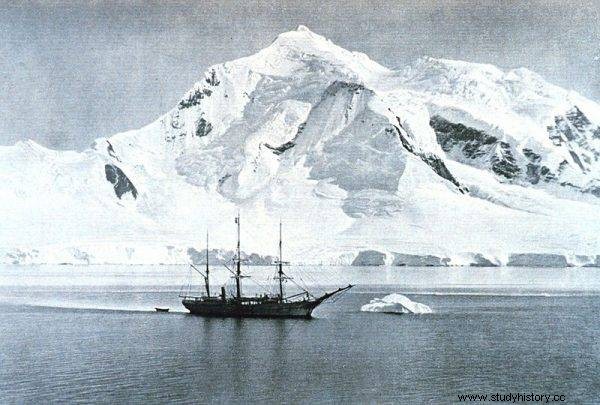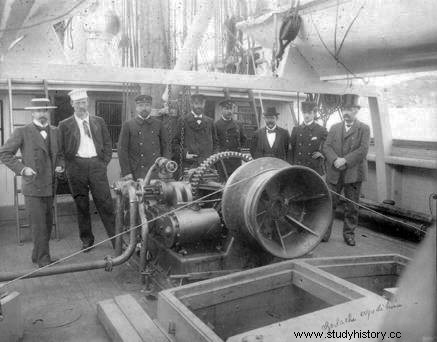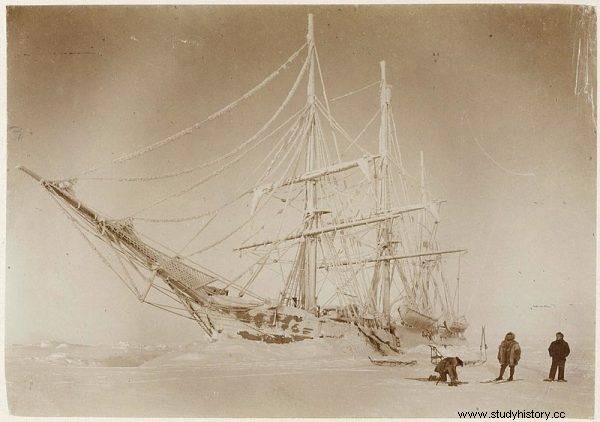In August 1897, Adrien de Gerlache and Roald Amundsen, aboard the Belgica ship, set off for the end of the Earth - the ice-covered continent of Antarctica.
Belgica left the port of Ostend on August 23, 1897, after sunset. "This time we are on our way," wrote the commander to Léonie Osterrieth. - "I preferred to go from the shore without the accompaniment of the orchestra and cheers." He finally started his journey, with thirteen Belgians on board, ten foreigners and two cats named Nansen and Sverdrup.
In the grip of seasickness
Long before Belgica faced the unknown dangers of Antarctica, she had to overcome the powerful storms that the Bay of Biscay was famous for off the coast of France. Strong winds pushed her south. As the ship swayed by the raging waves, the commander saw through the window of his cabin sometimes storm clouds, sometimes water swirling. (…)
The seasickness did not spare almost anyone. One of the young Norwegian sailors, Carl August Wiencke, described a drastic scene in his diary:“ The captain (Lecointe) is standing on the bridge, wielding the helm and vomiting. Scientists lie by the hatches and vomit. The mechanics sit in the engine room vomiting. And the panties are at the railings throwing up from the top deck. ”
Roald Admundsen's dream
(…) On September 13, after a three-day stay in Portuguese Madeira, Belgica raised the anchor and, taking advantage of the trade winds, continued its journey. To save coal, the fire was completely extinguished and all sails unfurled. As the ship neared the tropics, the temperature became more and more unbearable.

Belgica - Belgian research vessel that served in the Antarctic expedition in 1897-1899
To protect against burns, all bronze elements on the bridge were wrapped in sailcloth. An additional layer of insulation to protect against the Antarctic cold made it very difficult to exchange air below deck, which quickly led to temperatures reaching 55 degrees Celsius there . It was impossible to sleep in the cabins, so the sailors moved with hammocks to the amidships deck (...).
Roald Amundsen had dreamed of polar expeditions for so long that he considered this expedition his destiny. Like Cook, chose to follow in the footsteps of a father he hardly knew . Jens Amundsen, the shipowner and captain who made a living from the ongoing wars, spent most of his time away from home and eventually died at sea when his son was fourteen. Young Amundsen actually knew him only from stories (...). In Roald's mind, the man had an almost magical aura, and the boy did his best to match him.
Sir John Franklin - the man who ate his shoes
Time was to show that he would race with his legend throughout his life. Like de Gerlache, Amundsen grew up almost addicted to polar tales. A year after his father died, Roald found another idol, a British explorer in the early 19th century, Sir John Franklin.
A bald, stout navy officer whose expeditions into the Canadian arctic regions were marked by tragedy and wrong decisions, did not seem to be an obvious choice as a model for a young sailor. In 1819–1822, the Briton led a walking expedition along the Coppermine River , losing most of the people who had been murdered during it, died of starvation or exhaustion, and he was called "the man who ate his shoes".
In the mid-1840s, Franklin commanded the ships HMS Terror and HMS Erebus in an attempt to cross the Northwest Passage, but both units were crushed by ice, costing the lives of more than 130 people. On both expeditions led by Franklin, there were rumors of cannibalism that crew members were supposed to go to, but it was the difficulties and inhuman conditions that captured Amundsen's imagination (...).

The text is an excerpt from Julian Sancton's historical novel Madness at the End of the World. Belgica's expedition into the darkness of the Antarctic night, which has just been released by Media Rodzina.
As close to the pole as possible
However, the greatest influence on the life and choices of Roald Amundsen was the Norwegian scientist and discoverer Fridtjof Nansen. The traveler, who was eleven years older than Amundsen, achieved world fame in 1888 by skiing on the Greenland Ice Sheet . The tall blond man with bushy eyebrows and piercing blue eyes looked like he had been transferred from Norwegian legends alive. He was proclaimed a national hero even before Norway, which had been under Swedish rule since Napoleon, officially regained its independence.

Fridtjof Nansen
Seventeen-year-old Amundsen was among the thousands of onlookers who, on May 30, 1889, gathered along the shores of Kristianiafjorden to welcome Nansen's return:"a memorable day in the lives of many young Norwegians," Amundsen later recalled. - "It sure was to me."
Nansen raised the bar four years later when, during his expedition, the ship Fram was trapped by ice and drifted by sea currents for three years, to get closer to the North Pole than anyone before. Together with one of his companions, they went skiing and dog sled to the north, reaching a record 86 ° 13'6 "north latitude, which is a distance of about 365 kilometers from the pole.
After an exhausting journey back south, Nansen and his companion could not find the ship, as they expected, as Fram sailed away, drifting with the ice pack in which he was trapped. So they built a stone hut where they spent the winter feeding on meat. hunted bears and walruses then, with the advent of spring, they continued their journey south. In a miraculous twist of fate, they were saved by a nearby British polar expedition.
Preparing for Amundsen's expedition
Inspired by the achievements of Franklin and Nansen, Amundsen decided very early to become a polar explorer, and his desire over time turned into an ambition bordering on obsession . He was less interested in the scientific aspect of his research expeditions than de Gerlache and Cook - and much more in his hunger for the glory that could befall him.
Amundsen underwent exhausting physical and mental training, devoting him to all other aspects of his life, including education and love life. He slept with the window open all winter to keep his body accustomed to the cold , and made regular trips to the mountains surrounding Kristianiafjorden. Wanting to improve their cross-country skills and test the limits of their abilities, Amundsen and his brother Leon set off in January 1896 on an expedition through the dreaded Hardangervidd (...).
Amundsen's next step on his path was gaining experience at sea so that one day he could lead the polar expedition himself. To this end, he joined the crew of the ships Magdalena and Jason on the summer expedition of seal fishermen in the Arctic. It was after returning from that voyage to the Norwegian port of Sandefjord in July 1896 that the young man first saw Belgica, who was still being reworked in the same place to prepare her for the Antarctic mission (...).
Adoration to Neptune
Amundsen's path to the conquest of Antarctica was mapped out much earlier, methodically elaborated and planned down to the smallest detail. There was only one thing he could not foresee, as he had not prepared for the heat in the tropics, which had become unbearable when Belgica entered the equatorial silence belt.
Amundsen was one of thirteen to have never crossed the equator before. On October 6, according to the maritime custom, the initiation ceremony was to be held for all those who found themselves on the other side of the longest parallel for the first time . (…) The main points of the ceremony remain the same and include interrogation by Neptune, the god of the seas, and some form of ritual humiliation. . 
Some of the crew on board "Belgica"
On October 22, it was raining in a hurry when the mountain called Sugarloaf slipped over Belgica's starboard side. The heavy rain covered most of Guanabara Bay and the vast city of Rio de Janeiro from the sight of the seafarers, undermining the festive effect that de Gerlache had hoped for. He knew that were the first Belgian ship in years to call at this port. Nevertheless, they were noticed:a small steam unit moved towards them.
(…) Despite the turbulent times in Brazilian politics at the turn of the century, Belgian's presence in Guanabara Bay has become a national event. Loudly greeted at every turn, with the constant presence of journalists following all their movements, the members of the expedition spent their evenings reveling and treating their mornings with a hangover (...).
Romantic adventure
The Belgian Antarctic Expedition has been dressed in the robes of a science mission but was essentially a romantic adventure. De Gerlache organized it because the blank space at the bottom of the map attracted him like a magnet.
The void, which scientists on board Belgica had promised themselves to be filled with facts and data, was filled with fantasy and fiction for the needs of the moment. The human understanding of the unknown and unexplored Antarctica was shaped by literature for lack of other options - such as the science-inspired fiction by Jules Verne. (...) As de Gerlache boys and his subordinate officers, they read his books.

In August 1897, Adrien de Gerlache and Roald Amundsen, aboard the Belgica ship, set off for the end of the Earth - the ice-covered continent of Antarctica.
In 1870, the novel 20,000 Miles of Submarine Sailing was published in which Jules Verne described the South Pole as a rock protruding from an endless sea of ice, under which Nautilus could pass unhindered. Until 1897, when Belgica left the port, knowledge of Antarctica remained basically the same !! No one could unequivocally and categorically deny Verne's extensive and detailed vision.
The southernmost continent - as long as it was indeed a continent and not an ice island in the ocean - remained as mysterious as any other place Verne liked to portray:the interior of the Earth, the depths of the ocean, or the surface of the moon.
Source:
The text is an excerpt from Julian Sancton's historical novel Madness at the End of the World. Belgica's expedition into the dark of the Antarctic night , which has just been released by the Media Rodzina publisher.

